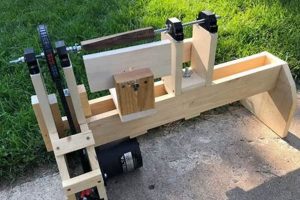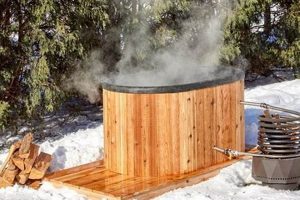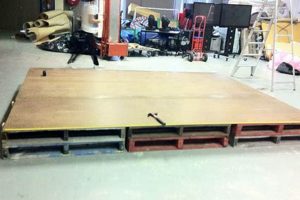A homemade smoker that utilizes compressed biomass fuel for cooking, typically involving modifying existing structures or building entirely from scratch. These projects often involve repurposing items and integrating electronic controls for automated fuel feeding and temperature regulation. An example includes converting a standard charcoal grill into a digitally controlled smoker using a custom-built hopper and auger system.
Construction of these devices offers significant cost savings compared to purchasing commercially available models. Individuals can customize the design and features to precisely match their specific cooking needs and preferences, potentially leading to increased cooking efficiency. Historically, smokers were primarily manually operated; however, the integration of electronic components in these builds demonstrates a modernization of traditional cooking methods.
The subsequent sections will delve into the component considerations, safety precautions, and potential challenges associated with constructing such a device. Further analysis will examine optimal designs and troubleshooting common operational issues.
Construction Guidance
The following guidelines serve to enhance the structural integrity, operational efficiency, and user safety during the build process.
Tip 1: Material Selection: Prioritize heavy-gauge steel for the cooking chamber to ensure consistent heat retention and structural stability. Avoid using galvanized metals in areas that will be directly exposed to heat, as they can release harmful fumes.
Tip 2: Hopper Design: Implement a conical hopper design to promote consistent fuel flow and prevent bridging. The hopper should be constructed from a material resistant to moisture and rodent damage to preserve fuel integrity.
Tip 3: Auger System Implementation: Select an auger motor with appropriate torque to reliably convey pellets from the hopper to the fire pot. Consider using a variable-speed motor for precise temperature control and fuel efficiency.
Tip 4: Temperature Control System: Utilize a PID (proportional-integral-derivative) controller for precise temperature regulation. Integrate a thermocouple positioned near the cooking surface to provide accurate temperature feedback.
Tip 5: Airflow Management: Ensure adequate airflow throughout the cooking chamber to promote efficient combustion and even heat distribution. Adjustable vents can be incorporated to fine-tune the cooking environment.
Tip 6: Safety Mechanisms: Implement safety features such as a high-temperature shutoff to prevent overheating and potential fires. All electrical components should be properly grounded and protected from the elements.
Tip 7: Welding Techniques: Employ proper welding techniques to ensure strong, airtight seams. Inadequate welds can lead to heat loss and structural failure. Seek professional assistance if welding skills are limited.
Adherence to these construction guidelines will significantly contribute to the longevity, performance, and safety of the finished smoker.
The subsequent section will address troubleshooting strategies for common issues encountered during operation and maintenance.
1. Component Selection
Effective assembly necessitates careful consideration of individual parts, as the functionality and longevity of the smoker are directly influenced by the quality and compatibility of selected components. This section outlines critical component aspects integral to reliable operation.
- Auger Motor Specifications
The auger motor’s torque and speed directly impact fuel delivery precision. Insufficient torque results in inconsistent pellet conveyance, leading to temperature fluctuations. Selecting a motor with variable speed capabilities permits finer temperature control, crucial for achieving desired cooking results. Example: A motor with a stall torque rating of at least 50 in-lbs is generally recommended for reliable operation with various pellet densities.
- Temperature Controller Type
The temperature controller regulates the combustion process to maintain consistent heat within the cooking chamber. PID (proportional-integral-derivative) controllers offer superior accuracy compared to simpler on/off controllers. A PID controller continuously adjusts the fuel feed rate based on real-time temperature feedback, minimizing temperature swings and ensuring precise cooking. The control system must be calibrated appropriately to ensure correct temperature sensing.
- Thermocouple Placement and Accuracy
The thermocouple serves as the primary temperature sensor, providing feedback to the control system. Its placement is critical for accurate temperature readings. Positioning the thermocouple too close to the heat source or too far from the cooking surface can skew readings, resulting in inaccurate temperature control. Thermocouple accuracy affects how well the control system operates. For example, a thermocouple with +/- 1-degree accuracy is a better option than one with +/- 5-degree accuracy.
- Steel Gauge for Hopper and Combustion Chamber
The gauge of steel used in the hopper and combustion chamber directly influences structural integrity and heat retention. Thicker steel provides superior heat retention, leading to more stable cooking temperatures and reduced fuel consumption. The gauge should be selected based on the anticipated operating temperatures and structural load. For example, 14-gauge steel is commonly used for the combustion chamber to withstand high temperatures.
Careful component selection, encompassing aspects from motor specifications to material gauge, significantly impacts the overall effectiveness of self-constructed devices. Optimal assembly necessitates a thorough understanding of the interplay between individual parts and their collective influence on performance.
2. Temperature Control
Temperature control is paramount in the successful operation of a homemade smoker using compressed biomass fuel. Imprecise temperature regulation directly affects the quality and consistency of the cooked product. Fluctuations can lead to uneven cooking, resulting in some areas being overcooked while others remain undercooked. For instance, maintaining a consistent 225F (107C) is crucial for proper smoking of brisket; deviations can cause the meat to become tough or fail to develop the desired smoke ring and flavor profile. The efficacy of temperature management is a determining factor in the overall success of the device.
The design and implementation of the temperature control system are closely linked to the performance of the fuel delivery system and the airflow dynamics within the cooking chamber. An inadequate fuel delivery mechanism, such as a poorly designed auger, can cause erratic pellet feeding, leading to abrupt temperature spikes or drops. Similarly, insufficient or uncontrolled airflow disrupts the combustion process, creating temperature inconsistencies throughout the smoker. Sophisticated control systems utilize feedback loops, continuously monitoring the internal temperature and adjusting the fuel feed rate accordingly, thereby mitigating temperature variations.
In summary, precise temperature control is an indispensable element in homemade compressed biomass fuel smokers. Successful integration of the fuel delivery system, airflow management, and feedback mechanisms is essential for achieving consistent and predictable cooking results. The absence of reliable temperature regulation undermines the entire purpose of the device.
3. Fuel Delivery
Fuel delivery represents a critical subsystem within any smoker utilizing compressed biomass fuel, directly influencing temperature stability and cooking performance. The primary function of this system is to precisely meter pellets from a storage hopper to the combustion chamber, ensuring a consistent fuel supply for maintaining a desired temperature. Malfunctions or inefficiencies within the delivery mechanism directly impact the smoker’s ability to hold a steady temperature, leading to variations in cooking times and results. For example, an improperly calibrated auger system might either underfeed pellets, causing the fire to diminish and the temperature to drop, or overfeed, leading to excessive smoke and potential temperature spikes. The reliability and precision of the fuel delivery system are therefore paramount.
Auger design, motor torque, and controller programming are crucial elements affecting fuel delivery accuracy. A poorly designed auger can jam or crush pellets, leading to inconsistent feed rates. Insufficient motor torque can result in the auger stalling under load, disrupting fuel flow entirely. The control algorithm must be programmed to accurately adjust the auger speed based on real-time temperature feedback, compensating for variations in pellet density and environmental conditions. For instance, a sophisticated control system might employ a PID (proportional-integral-derivative) algorithm to fine-tune the auger speed, minimizing temperature fluctuations. Moreover, the physical placement and orientation of the auger relative to the firepot are significant. Improper alignment can lead to uneven burning and potential back-burn issues.
In summation, the effectiveness of fuel delivery in a compressed biomass fuel smoker is inextricably linked to several factors: auger design, motor characteristics, and controller sophistication. Precise and consistent fuel delivery is essential for stable temperature control and repeatable cooking results. Design flaws or operational inefficiencies in this system inevitably lead to inconsistent performance and diminished user satisfaction. Addressing potential issues within the fuel delivery system is therefore a primary focus for any successful build.
4. Airflow Dynamics
Airflow dynamics is a critical, often overlooked, aspect in the design and functionality of a homemade smoker using compressed biomass fuel. Proper airflow ensures efficient combustion, even heat distribution, and the removal of exhaust gases, all of which directly impact cooking performance and safety. Inadequate management of airflow can lead to temperature inconsistencies, incomplete combustion, and the buildup of hazardous gases within the cooking chamber.
- Combustion Air Supply
The supply of oxygen is essential for the complete combustion of fuel pellets. Insufficient air results in incomplete combustion, producing excessive smoke, creosote buildup, and reduced heat output. Conversely, excessive air can lead to rapid fuel consumption and difficulty maintaining a stable temperature. Adjustable air inlets, strategically positioned near the firepot, enable precise control over the air supply, optimizing combustion efficiency. Example: Many successful builds incorporate adjustable vents at the base of the firepot to fine-tune the airflow based on pellet type and desired temperature.
- Convection and Heat Distribution
Airflow patterns within the cooking chamber dictate how heat is distributed around the food. Poor convection can create hot spots and cold spots, leading to uneven cooking. Designs incorporating baffles, diffusers, or convection fans promote uniform heat distribution, ensuring consistent cooking results. Example: A convection fan placed within the cooking chamber circulates hot air, minimizing temperature gradients and promoting even cooking.
- Exhaust Gas Removal
Efficient removal of exhaust gases is crucial for both cooking performance and safety. Inadequate venting can cause the buildup of smoke and harmful gases, imparting undesirable flavors to the food and posing a health hazard. Proper exhaust design ensures that exhaust gases are effectively removed from the cooking chamber without disrupting the internal airflow patterns. Example: A chimney or exhaust vent positioned at the top of the cooking chamber facilitates the natural upward flow of exhaust gases, preventing buildup and promoting efficient venting.
- Draft Control and Stability
Maintaining a consistent draft is essential for stable temperature control, particularly in windy conditions. External drafts can disrupt the airflow patterns within the smoker, leading to temperature fluctuations. Designs incorporating draft dampers or windbreaks can mitigate the effects of external drafts, ensuring consistent cooking performance. Example: A draft damper installed in the chimney allows for fine-tuning of the exhaust flow, compensating for variations in wind conditions and maintaining a stable draft.
The factors outlined have a profound influence on both the performance and safety of the compressed biomass fuel smoker. Optimizing these aspects of airflow dynamics is critical for achieving consistent cooking results, maximizing fuel efficiency, and minimizing potential hazards.
5. Safety Protocols
Adherence to established safety protocols is paramount during the design, construction, and operation of a self-built smoker utilizing compressed biomass fuel. The absence of formalized manufacturing standards necessitates meticulous attention to detail to mitigate potential hazards and ensure safe operation.
- Electrical Safety
Given the integration of electrical components such as auger motors, temperature controllers, and heating elements, proper wiring, grounding, and insulation are essential. Exposed wiring poses a significant risk of electric shock. All electrical connections must conform to established electrical codes, and the entire assembly should be protected by a ground fault circuit interrupter (GFCI). Example: Employing weatherproof enclosures for all electrical components and regularly inspecting wiring for damage are crucial preventative measures.
- Fire Prevention
Compressed biomass fuel, while generally safe, presents a fire hazard if improperly managed. Overfilling the hopper, allowing excessive creosote buildup, or operating the device near flammable materials can lead to uncontrolled fires. Implementing a high-temperature shutoff mechanism that automatically cuts power to the auger motor in the event of overheating is a critical safety feature. Example: Maintaining a minimum clearance of 10 feet from any combustible structure and regularly cleaning the firepot to remove ash and creosote buildup are essential fire prevention practices.
- Material Safety
The selection of appropriate materials is crucial for ensuring the structural integrity and safe operation of the smoker. Utilizing galvanized steel or other materials that release toxic fumes when heated poses a significant health risk. All materials used in the construction of the cooking chamber and firepot must be rated for high-temperature applications and be free of potentially harmful coatings or contaminants. Example: Prioritizing stainless steel or high-temperature-rated carbon steel for the cooking chamber and avoiding the use of treated lumber or plastics in areas exposed to heat are essential material safety considerations.
- Carbon Monoxide Mitigation
Incomplete combustion of fuel pellets can produce carbon monoxide (CO), a colorless and odorless gas that is highly toxic. Operating the smoker in a well-ventilated area is essential to prevent the buildup of CO to dangerous levels. Installing a carbon monoxide detector in close proximity to the operating area provides an additional layer of safety. Example: Never operating the smoker indoors or in enclosed spaces and ensuring adequate ventilation are crucial steps in mitigating the risk of carbon monoxide poisoning.
The implementation of comprehensive safety protocols is not merely a recommendation but a necessity for individuals undertaking the construction and operation of self-built smokers utilizing compressed biomass fuel. Diligent adherence to these guidelines minimizes the potential for accidents and ensures a safe cooking environment.
6. Welding Integrity
The structural stability and operational safety of a homemade smoker employing compressed biomass fuel are intrinsically linked to the quality of welding executed during its construction. Compromised welds introduce potential points of failure, leading to heat loss, structural instability, and, in extreme cases, catastrophic collapse. Therefore, meticulous attention to welding techniques and inspection is paramount.
- Seam Strength and Airtightness
Welds serve as the primary bonds between metal components, forming seams that must withstand high temperatures and mechanical stresses. Inadequate weld penetration or porosity creates weak points prone to cracking and failure. Airtight seams are essential for maintaining consistent internal temperatures and preventing unwanted air leaks, which disrupt airflow dynamics and fuel efficiency. Example: Butt welds on the firebox must exhibit full penetration to prevent burn-through and maintain structural integrity at elevated temperatures.
- Material Compatibility and Weld Selection
Dissimilar metals possess varying thermal expansion coefficients and may react negatively when welded together, creating stress concentrations and potential corrosion. Selecting appropriate welding processes and filler materials compatible with the base metals is crucial for ensuring weld integrity and longevity. Example: When joining stainless steel to carbon steel, the use of a specialized filler alloy designed for dissimilar metal welding prevents galvanic corrosion at the weld interface.
- Welding Technique and Skill Level
The proficiency of the welder directly impacts the quality and consistency of the welds. Improper welding techniques, such as insufficient heat input or incorrect travel speed, result in weak or porous welds. Individuals with limited welding experience should seek professional assistance or undergo proper training to ensure welds meet required standards. Example: Consistent bead placement and proper arc control are essential for achieving uniform weld penetration and preventing undercut, which weakens the joint.
- Inspection and Testing Methods
Visual inspection alone is insufficient to detect all weld defects. Employing non-destructive testing methods, such as dye penetrant inspection or ultrasonic testing, can reveal subsurface flaws that would otherwise go unnoticed. Regular inspection of welds, particularly in high-stress areas, is essential for identifying potential issues before they escalate into major failures. Example: Dye penetrant testing can reveal surface cracks and porosity, allowing for timely repairs and preventing further degradation of the weld.
In conclusion, the welding quality directly impacts the structural integrity and safe operation of the smoker. Consistent weld integrity must be maintained throughout the fabrication process to enhance longevity.
7. Material Durability
Material durability is a foundational concern in the construction of homemade smokers utilizing compressed biomass fuel. The operating environment subjects the constituent materials to high temperatures, corrosive byproducts of combustion, and potential exposure to the elements. Consequently, the selection of durable materials directly influences the lifespan, safety, and overall performance of the device.
- Corrosion Resistance
The combustion of wood pellets generates acidic gases and moisture, creating a corrosive environment within the cooking chamber. Materials susceptible to corrosion degrade over time, compromising structural integrity and potentially contaminating food. Stainless steel, particularly grades 304 and 316, offers superior corrosion resistance compared to carbon steel and is frequently employed in critical components such as the firepot and cooking grates. For example, carbon steel fireboxes can experience significant rusting and degradation within a few years of use, necessitating costly repairs or replacements, while stainless steel components maintain their structural integrity for a considerably longer duration.
- High-Temperature Stability
The firepot and surrounding areas are exposed to extremely high temperatures, often exceeding 500 degrees Fahrenheit (260 degrees Celsius). Materials must retain their structural integrity and resist deformation or failure at these temperatures. High-temperature-rated carbon steel, cast iron, and certain grades of stainless steel exhibit excellent high-temperature stability. The use of lower-grade materials can lead to warping, cracking, and ultimately, structural failure of the smoker. For instance, thin-gauge, unrated steel can deform significantly under high heat, leading to air leaks and uneven temperature distribution.
- Resistance to Thermal Cycling
Smokers undergo repeated heating and cooling cycles, which induce thermal stress within the materials. Materials with poor resistance to thermal cycling are prone to fatigue, cracking, and eventual failure. Selecting materials with low coefficients of thermal expansion and high thermal conductivity minimizes stress concentrations and enhances resistance to thermal fatigue. Example: Ceramic coatings, while offering excellent high-temperature resistance, can be susceptible to cracking under repeated thermal cycling if applied improperly or to incompatible substrates.
- Structural Integrity Under Load
The cooking chamber and supporting structures must withstand the weight of the food being cooked, as well as any additional stresses imposed by wind or uneven terrain. Selecting materials with adequate strength and stiffness is crucial for ensuring structural stability and preventing deformation or collapse. For example, heavy-gauge steel framing and reinforced welds are essential for supporting large quantities of food within the cooking chamber.
The longevity, safety, and cooking performance of self-constructed smokers depend critically on appropriate material choices. By prioritizing corrosion resistance, high-temperature stability, resistance to thermal cycling, and structural integrity, builders enhance the reliability and extend the service life of their creations. Careful consideration of these material properties is therefore an investment in the long-term value and utility of the device.
Frequently Asked Questions
The following addresses common inquiries regarding the design, construction, and operation of compressed biomass fuel smokers, providing clarity on potential challenges and best practices.
Question 1: Is previous welding experience required to undertake such a project?
While not strictly mandatory, welding proficiency significantly enhances the likelihood of a successful and structurally sound build. Inadequate welding skills can compromise the integrity of seams, leading to heat loss and potential structural failure. Individuals lacking welding expertise should seek professional assistance or undergo appropriate training.
Question 2: What is the approximate cost savings compared to purchasing a commercially manufactured model?
Cost savings vary depending on the materials used and the complexity of the design. However, it is generally possible to realize a substantial reduction in expenses, potentially exceeding 50%, by constructing the device oneself. This assumes access to tools and fabrication equipment and the ability to source materials at competitive prices.
Question 3: How crucial is precise temperature control for optimal results?
Precise temperature regulation is paramount for achieving consistent cooking outcomes. Fluctuations in temperature can lead to uneven cooking and undesirable flavor profiles. Implementing a PID (proportional-integral-derivative) controller and strategically positioning a thermocouple are essential for maintaining stable temperatures.
Question 4: What safety precautions must be strictly adhered to?
Rigorous adherence to safety protocols is non-negotiable. This includes proper electrical grounding, fire prevention measures, selection of safe materials, and ensuring adequate ventilation to mitigate the risk of carbon monoxide poisoning. Failure to prioritize safety can result in serious injury or property damage.
Question 5: What type of steel is best suited for the cooking chamber?
Heavy-gauge stainless steel (e.g., 304 or 316) offers superior corrosion resistance and high-temperature stability, making it an ideal choice for the cooking chamber. While carbon steel can be used, it requires regular maintenance and is more susceptible to rust and degradation.
Question 6: How often should the internal components be cleaned?
Regular cleaning is essential for maintaining optimal performance and preventing the buildup of creosote and ash. The frequency of cleaning depends on usage but generally should be performed after every 2-3 uses. Neglecting cleaning can lead to reduced airflow, inefficient combustion, and potential fire hazards.
The preceding responses underscore the importance of careful planning, skilled execution, and diligent safety practices in the construction and operation of a compressed biomass fuel smoker.
The subsequent section provides resources and further references.
Conclusion
The preceding analysis has explored the multifaceted aspects of constructing a compressed biomass fuel smoker, encompassing design considerations, component selection, operational parameters, and critical safety protocols. Emphasis has been placed on the necessity of precise temperature control, efficient fuel delivery, and robust material selection to ensure both performance and longevity. The integrity of welds and adherence to safety guidelines have been underscored as paramount concerns.
Successful implementation of this device necessitates a commitment to rigorous planning, skilled execution, and continuous monitoring of operational parameters. While significant cost savings are attainable, the undertaking demands a thorough understanding of engineering principles and a dedication to safety. Further research and adherence to best practices are strongly encouraged to maximize the efficacy and minimize the potential hazards associated with this endeavor.





![[DIY Guide] Easy DIY Wood Window Shutters You Can Build! The DIY Hub: Creative Crafts, Repairs & Life Hacks [DIY Guide] Easy DIY Wood Window Shutters You Can Build! | The DIY Hub: Creative Crafts, Repairs & Life Hacks](https://craftingdiycenter.com/wp-content/uploads/2025/07/th-3579-300x200.jpg)

